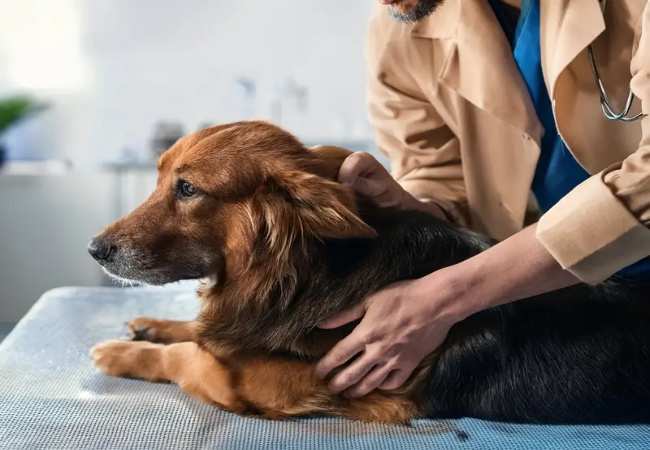Vet Approved Guide to Common Shoulder Injuries in Dogs: Signs, Treatment & Recovery (2025)🩺🐶

In this article
Vet Approved Guide to Common Shoulder Injuries in Dogs: Signs, Treatment & Recovery (2025)🩺🐶
By Dr. Duncan Houston BVSc
Shoulder injuries in dogs are more common than many owners realize—and if left untreated, they can lead to chronic pain, arthritis, or limited mobility. As a veterinarian, I often see pups limping, reluctant to play, or showing stiffness after exercise—classic signs of a shoulder strain or joint problem. 🩺🐾
This guide outlines the most frequent canine shoulder injuries, how to spot them, and how to support healing through rest, rehabilitation, and tools like Ask A Vet. 🧠
🔍 Signs of Shoulder Injury in Dogs
Shoulder problems typically affect the front leg and may present as:
- 🚶♂️ Limping (often intermittent at first)
- 🏋️♂️ Weight shifting to opposite limb
- 🪑 Difficulty rising or jumping
- 🛋️ Stiffness after rest
- 🗣️ Yelping or pulling away during shoulder handling
If symptoms last more than 48 hours or worsen, it’s time to consult your vet or use Ask A Vet for immediate guidance. 🩺
🦴 Common Types of Shoulder Injuries in Dogs
1. 🧠 Soft Tissue Strain or Sprain
- Affects muscles, ligaments, or tendons surrounding the shoulder joint
- Usually caused by jumping, twisting, or rough play
- Treated with rest, cold therapy, and light rehab
2. 🧬 Biceps Tendonitis
- Inflammation of the biceps brachii tendon in the shoulder
- Seen in athletic or working dogs
- May require anti-inflammatories, rehab, or surgery if severe
3. 🔩 Osteochondritis Dissecans (OCD)
- Developmental joint disease causes cartilage damage
- Often affects large-breed puppies (6–12 months old)
- Treated surgically or with joint-supportive care
4. 💥 Shoulder Luxation (Dislocation)
- Occurs from trauma or a congenital abnormality
- Requires immediate veterinary intervention
5. 🧠 Supraspinatus or Infraspinatus Injuries
- Involve deep rotator cuff muscles
- Common in agility or working dogs
- Can lead to muscle contracture if not treated early
📋 Diagnosing Shoulder Injuries
- 🩺 Physical exam (range of motion, pain points)
- 🧪 Imaging: X-rays, ultrasound, or MRI for detailed evaluation
- 🧠 Rule out spinal or elbow causes of forelimb lameness
Ask A Vet can help interpret diagnostic findings or recommend next steps post-clinic visit. 📱
⚕️ Treatment Options
Conservative Management:
- 🛏️ Crate rest or restricted activity for 2–6 weeks
- 🧊 Ice therapy during first 72 hours (15 min intervals)
- 💊 Anti-inflammatory medication
- 🧘 Gentle physiotherapy or passive range-of-motion exercises
Advanced Therapy:
- 🏊 Hydrotherapy or underwater treadmill
- 🔬 Laser therapy or acupuncture
- 💉 Joint injections (PRP or stem cell in severe cases)
Surgical Repair:
Used for severe OCD, torn tendons, or chronic instability. Post-surgical care includes crate rest and progressive rehab. 🦴
🧬 Breeds Prone to Shoulder Injuries
- 💥 Labrador Retrievers (high energy + weight)
- 🏃 Border Collies (agility and sudden stops)
- 🐕 German Shepherds (large frame, active)
- 🧸 Poodles and Goldendoodles (high jumpers)
Monitor these breeds closely during and after high-impact play. 🕵️♂️
📅 Recovery Timeline (General)
- Minor sprain: 2–4 weeks
- Biceps tendonitis: 6–12 weeks
- Surgery (OCD/luxation): 8–16 weeks with rehab
Always confirm timelines with your vet or use Ask A Vet for virtual recovery planning. 🩺
✅ Final Thoughts: Early Action = Long-Term Mobility
Shoulder injuries are painful, but with early diagnosis and proper care, most dogs make a full recovery. Know the signs, get professional guidance, and support your pup’s healing journey with a mix of rest, rehab, and gentle enrichment. 🐶❤️
Quick Recap:
- 🦴 Watch for limping, stiffness, or shoulder pain
- 🩺 Get imaging and diagnosis ASAP
- 🛏️ Rest, anti-inflammatories, and controlled activity are key
- 📱 Use Ask A Vet for support during recovery
Need help now? Visit AskAVet.com. 🐾






